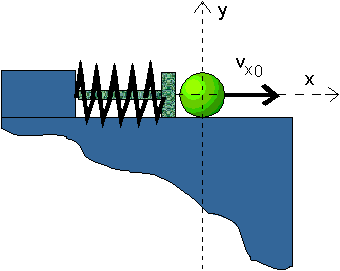 Preparation
in classical physics
Preparation
in classical physics Preparation
in classical physics
Preparation
in classical physics If,
for example, the law of motion for the horizontal throw of a ball is to
be tested a device has to be set up which makes it possible to throw balls
with definite initial values of position and velocity. The device shown
in the figure prepares balls with the two properties "is located at the
position (x0, y0)" and "has the initial velocity
(vx0,vy0)".
If,
for example, the law of motion for the horizontal throw of a ball is to
be tested a device has to be set up which makes it possible to throw balls
with definite initial values of position and velocity. The device shown
in the figure prepares balls with the two properties "is located at the
position (x0, y0)" and "has the initial velocity
(vx0,vy0)".
This example demonstrates a main difference between classical and quantum mechanics. In classical physics, there is no principle obstacle for preparing simultaneously position and velocity (momentum) in the same direction.In quantum mechanics, there are fundamental limits of nature placed upon the simultaneous preparation of certain pairs of properties. This is described by Heisenberg`s uncertainty principle.